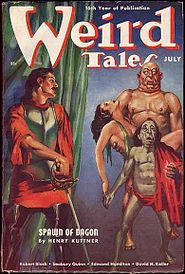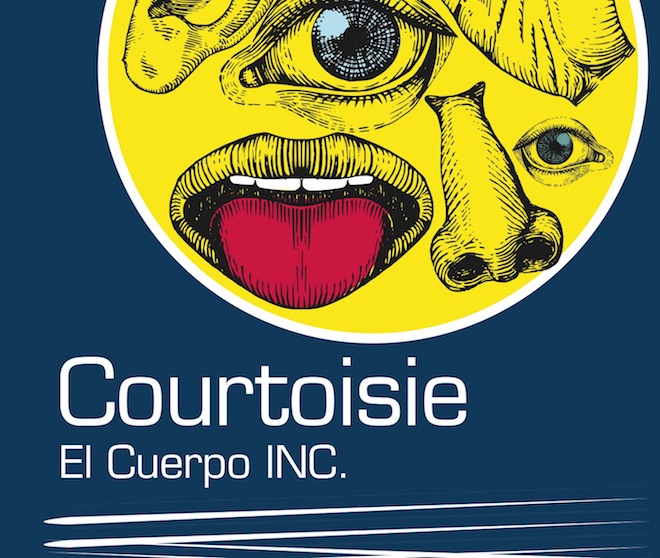 Henry Kuttner deserves our thanks. If things had been left to Clifford Ball, Sword & Sorcery would have fizzled out in the pages of Weird Tales. Ball, who we know very little about, was the first to take up the torch of Sword & Sorcery from Howard’s dead hand. He wrote four stories “Duar the Accursed” (May 1937), “The Thief of Forthe” (July 1937), “The Goddess Awakes” (February 1938) and “The Swine of Aeaea” (March 1939), all of which are interesting to scholars but none of which is above the mediocre in quality. It may be because Ball was a young, inexperienced writer. But if that was the case, it doesn’t explain why Henry Kuttner, himself only 24, was able to write the four tales of Elak of Atlantis that served as a guide for all who followed.
Henry Kuttner deserves our thanks. If things had been left to Clifford Ball, Sword & Sorcery would have fizzled out in the pages of Weird Tales. Ball, who we know very little about, was the first to take up the torch of Sword & Sorcery from Howard’s dead hand. He wrote four stories “Duar the Accursed” (May 1937), “The Thief of Forthe” (July 1937), “The Goddess Awakes” (February 1938) and “The Swine of Aeaea” (March 1939), all of which are interesting to scholars but none of which is above the mediocre in quality. It may be because Ball was a young, inexperienced writer. But if that was the case, it doesn’t explain why Henry Kuttner, himself only 24, was able to write the four tales of Elak of Atlantis that served as a guide for all who followed.
 It really fell to Kuttner to take what Robert E. Howard did and see what pattern was there for new writers wishing to create a Sword & Sorcery tale. He did this with the four Elak tales and then two more in the Prince Raynor series for Strange Tales. Kuttner began his career by emulating his heroes, Robert E. Howard and H. P. Lovecraft. His first story for Weird Tales was as Joe R. Lansdale calls it “a classic little booger tale”, “The Graveyard Rats” (March 1936). Kuttner worked in many different styles and genres but the Elak stories don’t feel like the potboilers he wrote for Thrilling Mystery. The Elak stories show small pieces of Howardiana in them (like the name Pihkt instead of Pict) but they are not Conan retread. Kuttner tries his own blend of Merritt-esque weirdness and Howardian daring-do. The pattern will be set for all the writers who will re-discover S&S in the early 1960s.
It really fell to Kuttner to take what Robert E. Howard did and see what pattern was there for new writers wishing to create a Sword & Sorcery tale. He did this with the four Elak tales and then two more in the Prince Raynor series for Strange Tales. Kuttner began his career by emulating his heroes, Robert E. Howard and H. P. Lovecraft. His first story for Weird Tales was as Joe R. Lansdale calls it “a classic little booger tale”, “The Graveyard Rats” (March 1936). Kuttner worked in many different styles and genres but the Elak stories don’t feel like the potboilers he wrote for Thrilling Mystery. The Elak stories show small pieces of Howardiana in them (like the name Pihkt instead of Pict) but they are not Conan retread. Kuttner tries his own blend of Merritt-esque weirdness and Howardian daring-do. The pattern will be set for all the writers who will re-discover S&S in the early 1960s.
Kuttner begins with “Thunder In the Dawn” (May 1938), a tale beginning in an inn (how appropriate for all those D&D players!) Elak, who is actually King Zeulas in disguise, is attacked by an agent of Elf, a wizard who threatens Cyrena, where Elak’s brother sits on the throne. Elak and his friends head north, followed by the vengeful Lord Granicor. They face a number of enemies before attacking Elf in his weird castle.
 “Spawn of Dagon” (July 1938) follows a similar plot to Howard’s “Rogues in the House” when Elak and Lycon enter a wizard’s house to steal a precious gem. As usual the people the heroes are working for are even more evil than the magician, a race of Lovecraftian squidgies, intent on taking over all of Atlantis.
“Spawn of Dagon” (July 1938) follows a similar plot to Howard’s “Rogues in the House” when Elak and Lycon enter a wizard’s house to steal a precious gem. As usual the people the heroes are working for are even more evil than the magician, a race of Lovecraftian squidgies, intent on taking over all of Atlantis.
“Beyond the Phoenix” (October 1938) has Elak and Lycon defy the wizard Xander who has lead a coup against King Phyrgior. Elak must take an enchanted amulet beyond the veil to a realm of the Phoenix that opposes Xander’s evil Lovecraftian god. The raft sequence in this story will appear again in John Jakes’ Brak. Kuttner may have borrowed it from Edgar Rice Burroughs’ Gods of Mars, and Burroughs from Rider Haggard…
“Dragon Moon” (January 1941) is really the second half of “Thunder in the Dawn”, when Elak’s brother is killed and a second army threatens to take over Cyrena. This time the invaders are lead by Karkora, a demon who has possessed the neighboring king. Elak and Dalan head north, rally Elak’s kinsmen then face a desperate battle for the future of Cyrena and the human race. The tale ends with Elak home and king at last.
 The Prince Raynor stories differ in tone for they are about another character, Prince Raynor, who witnesses his father cut down by the usurping King Cyaxares. Because of this, “Cursed Be the City” (Strange Stories, April 1939) is all about revenge, making it less carefree to Elak’s drunken dalliances. Raynor, with his companion, Eblik, a former slave, seeks out the Reaver of the Rock who holds a magical doom in abeyance. Raynor releases that doom unto his city as well as falls for the Reaver’s daughter, Delphia.
The Prince Raynor stories differ in tone for they are about another character, Prince Raynor, who witnesses his father cut down by the usurping King Cyaxares. Because of this, “Cursed Be the City” (Strange Stories, April 1939) is all about revenge, making it less carefree to Elak’s drunken dalliances. Raynor, with his companion, Eblik, a former slave, seeks out the Reaver of the Rock who holds a magical doom in abeyance. Raynor releases that doom unto his city as well as falls for the Reaver’s daughter, Delphia.
“The Citadel of Darkness” (Strange Stories, August 1939) follows the trio fleeing the destruction of Sardopolis. Delphia is taken by bandits then stolen by a wizard, Ghiar, who plans to use Delphia’s virgin blood for a great evil. The two heroes venture into Ghiar’s weird underground realm, fight the following bandits and defeat Ghiar in a battle of cosmic size. Strange Stories folded after 13 issues, ending the Raynor tales.
Henry Kuttner walked away from Sword & Sorcery after 1940. There are two obvious reasons for this. The first was that Weird Tales no longer wanted to publish Howardian Fantasy (though they did continue with some Science Fantasy tales by Edmond Hamilton). Without a market, Kuttner moved onto magazines that would pay. For he now had another reason. He had married C. L. Moore in 1940, and the two began a long collaborative career that would create such Science Fiction classics as “The Twonky”, “Mimsey Were the Borogoves and “Vintage Season”. Henry Kuttner died in 1958 so he did not see the revival of S&S that would come ten years later. This explains why his Elak and Prince Raynor tales never received their own mass market volume until 2007. If he had lived longer we would most likely have seen such a book sooner and possibly some new Elak tales. We can only imagine what marvels we have missed.











Recent Comments